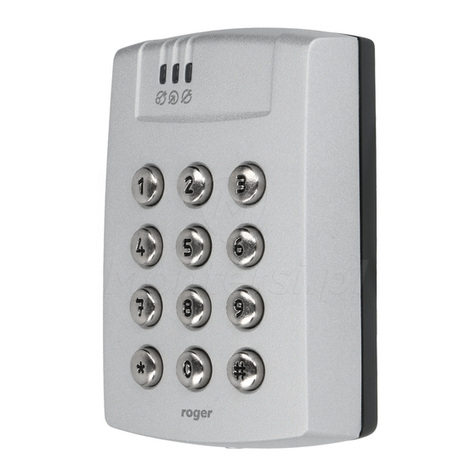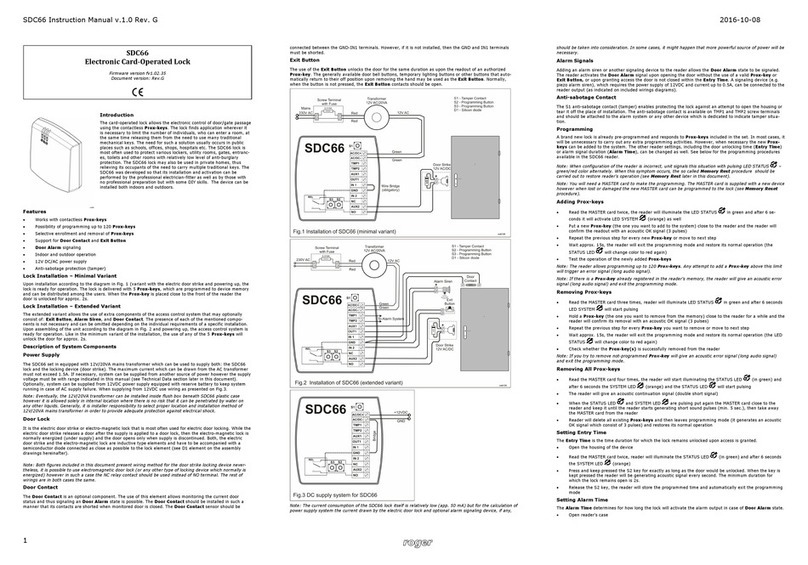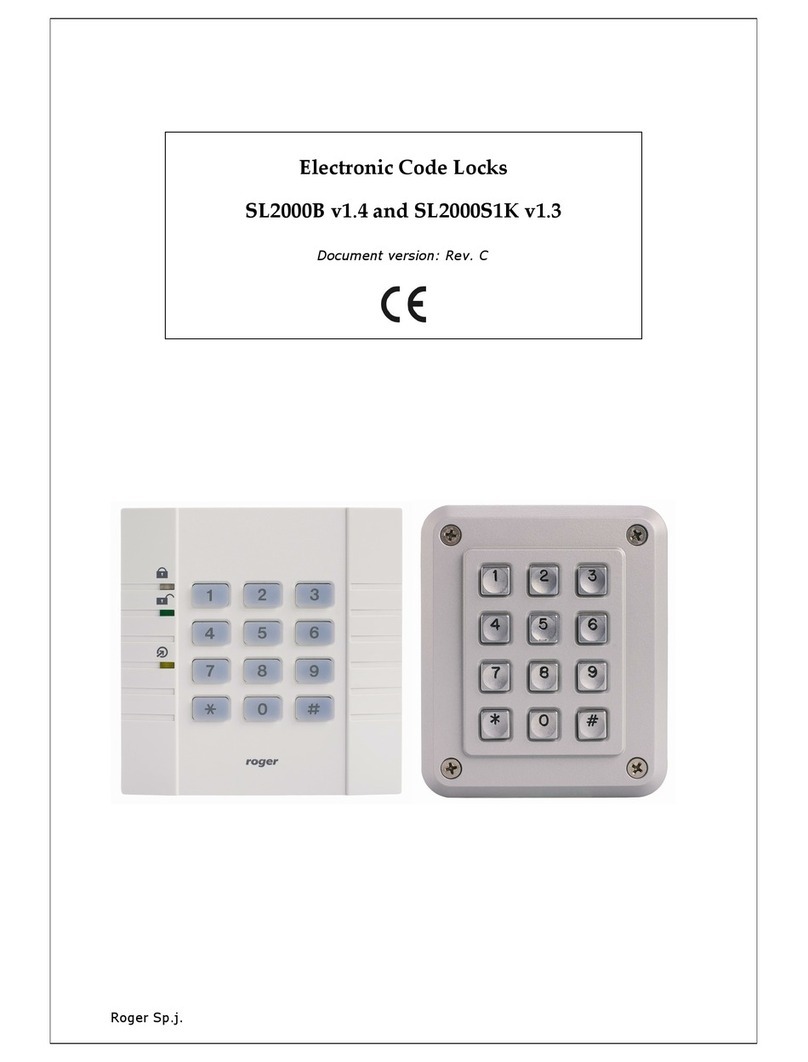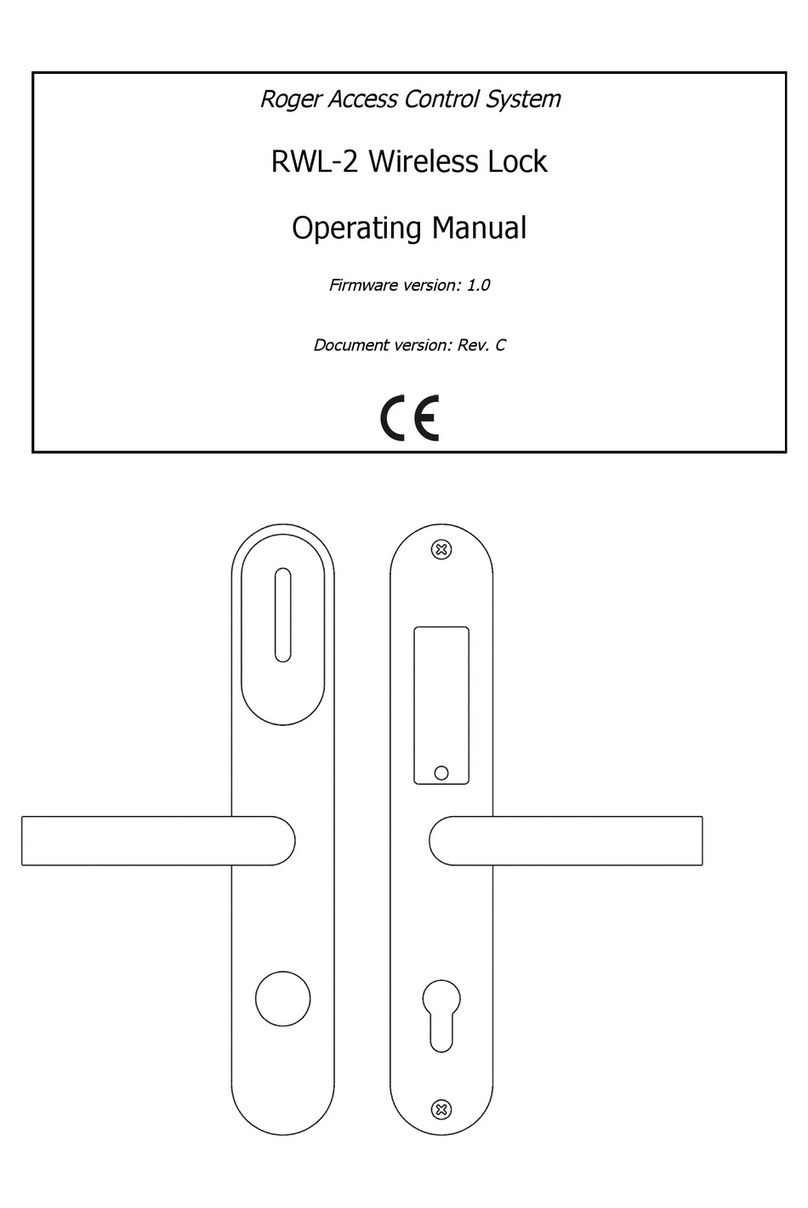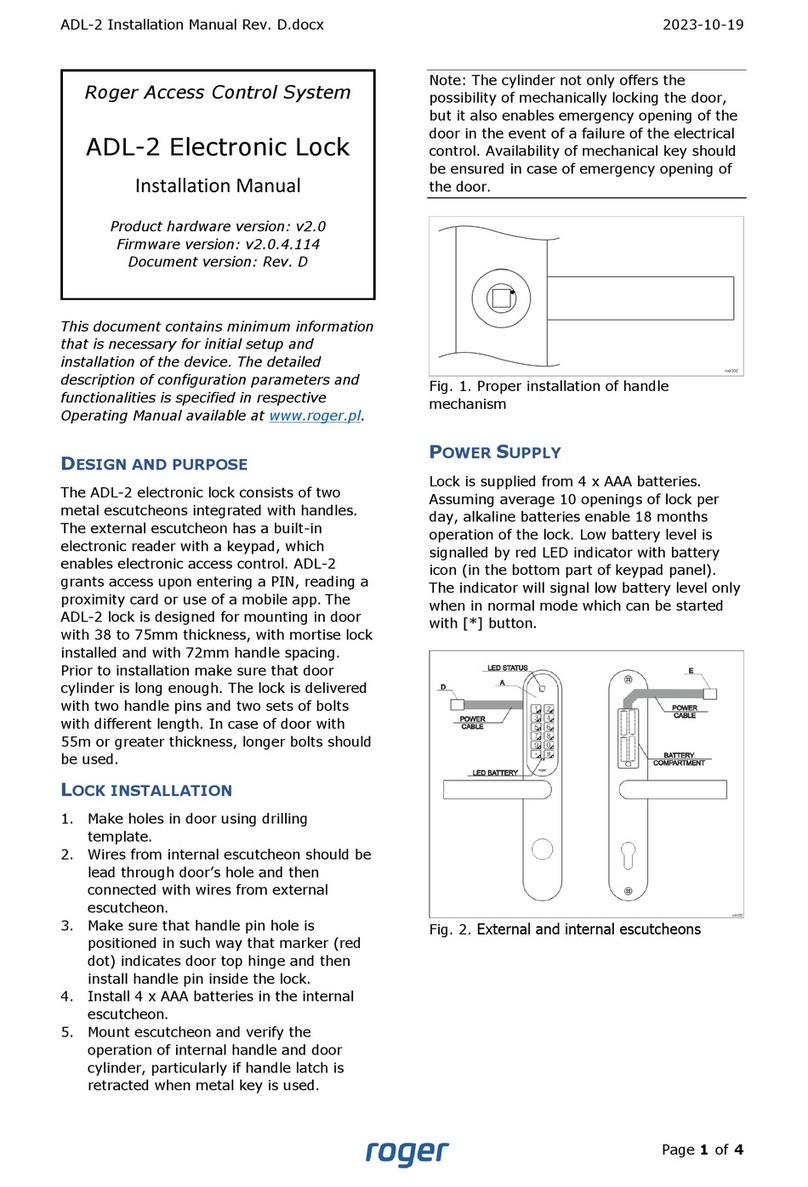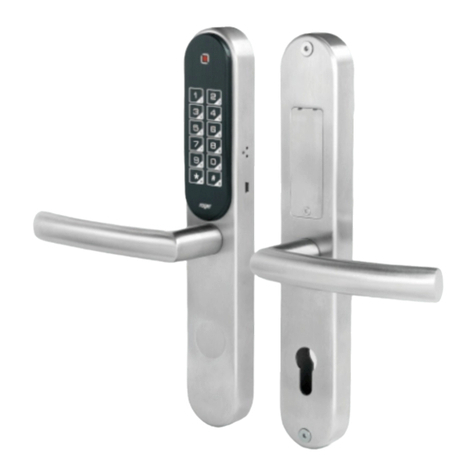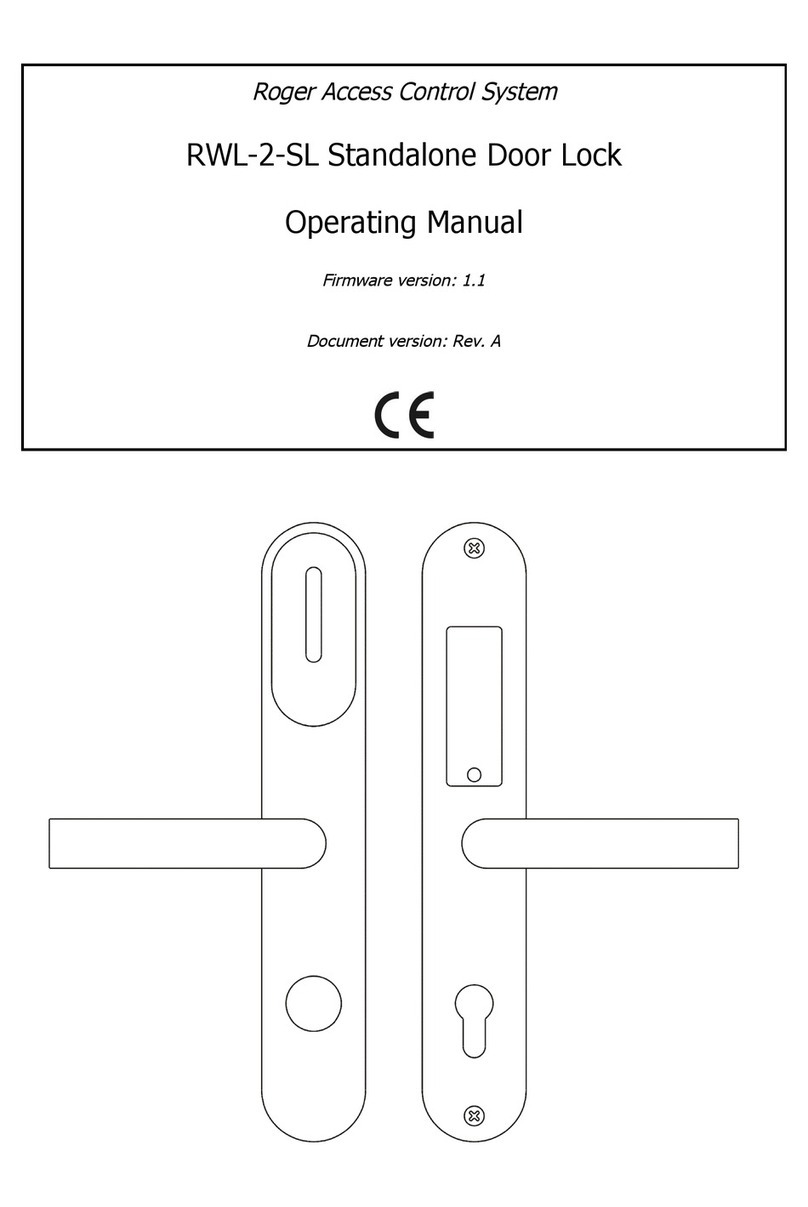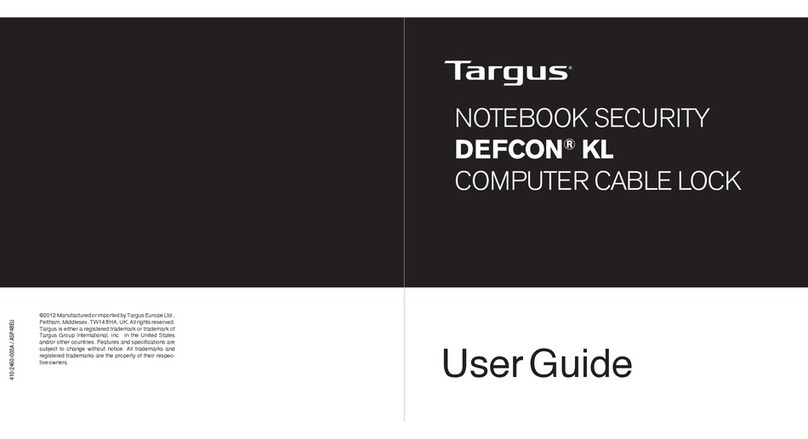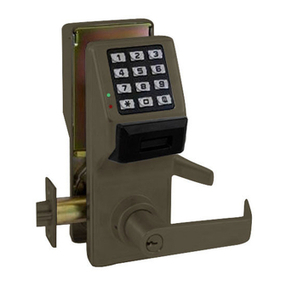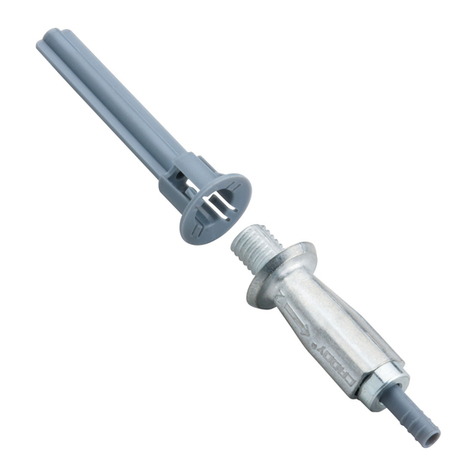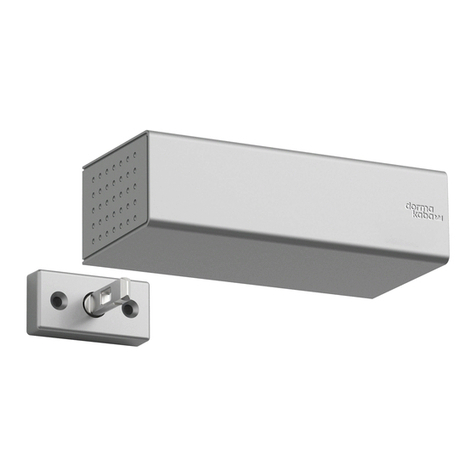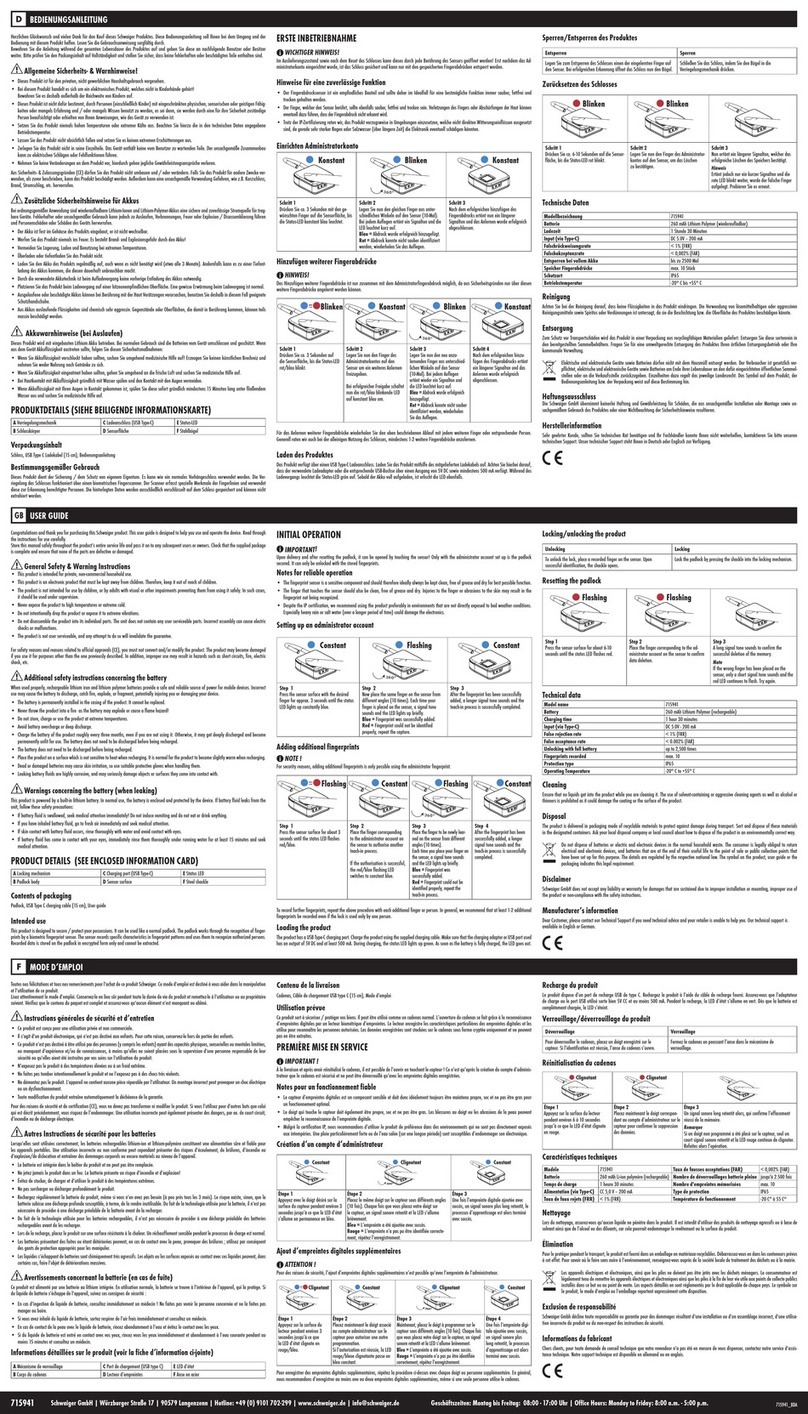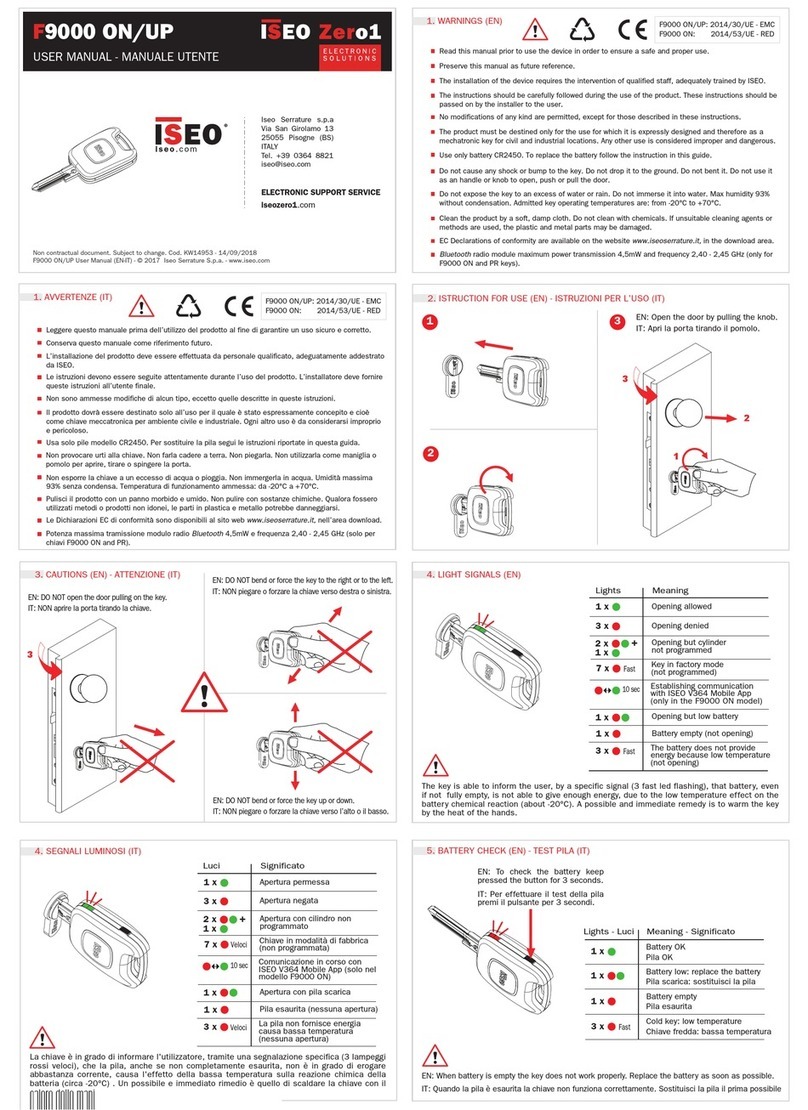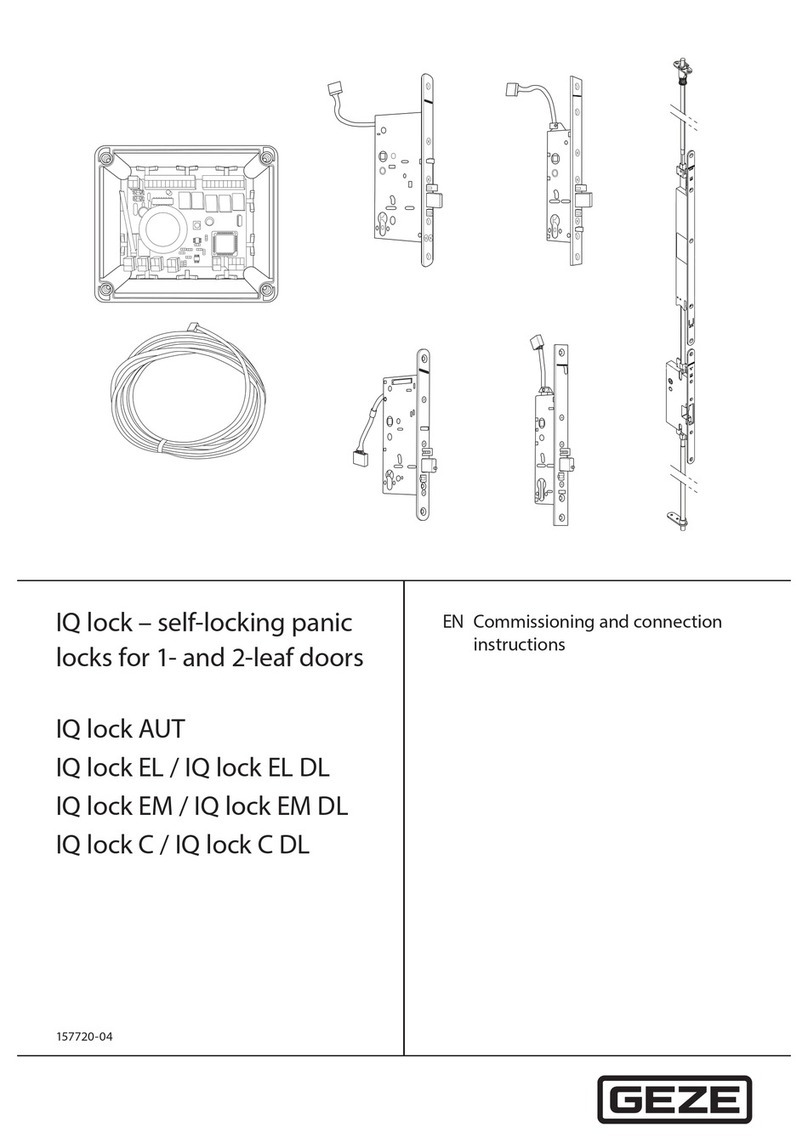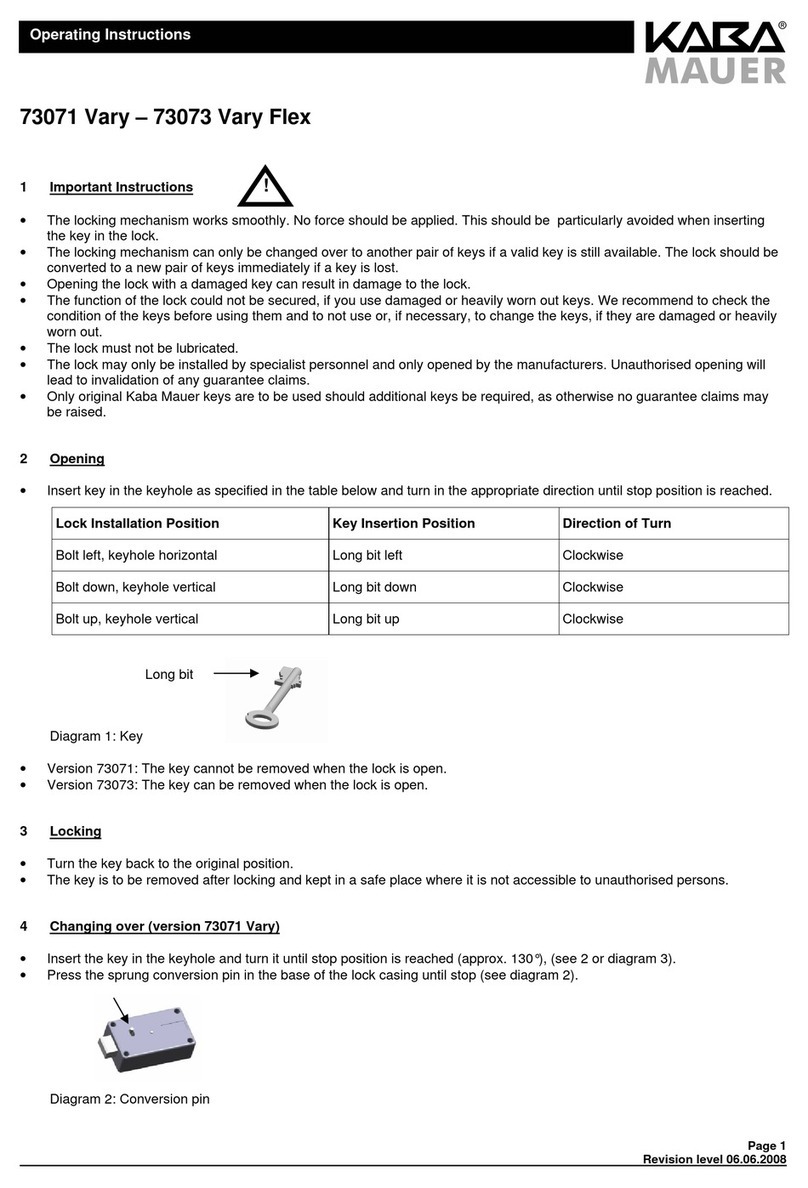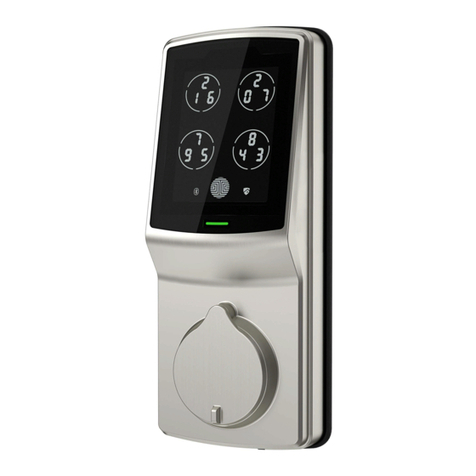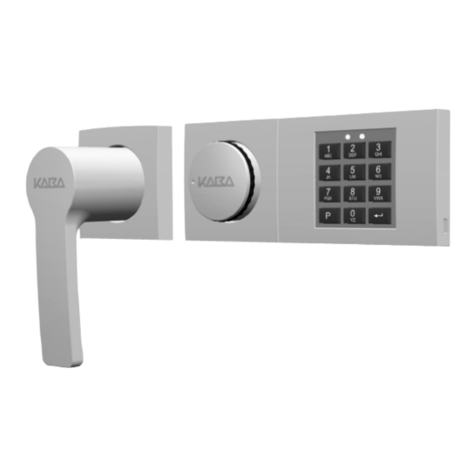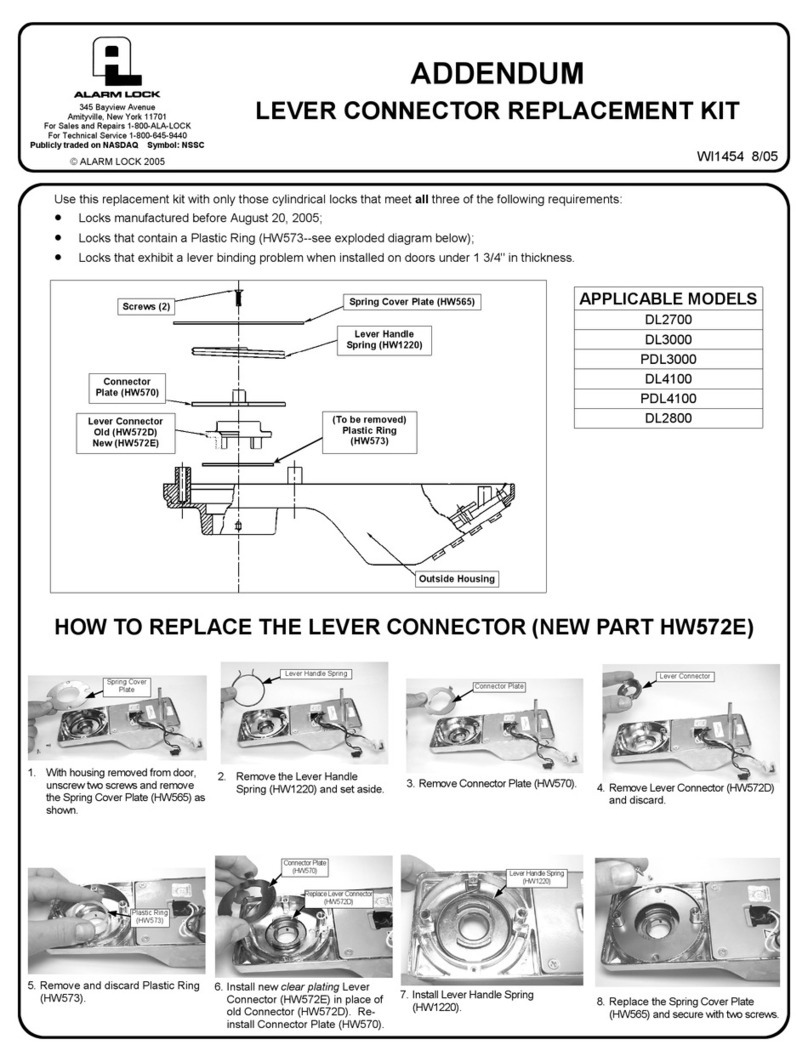Roger RWL-1-SL User manual

Roger Access Control System
RWL-1-SL Standalone Door Lock
Operating Manual
Firmware version: 1.1
Document version: Rev. A

RWL-1-SL Operating Manual.doc 2021-12-20
2/13
DESIGN AND APPLICATION
RWL-1-SL lock enables read-in access control based on MIFARE proximity cards - based on the card
numbers stored in its memory, the lock decides autonomously if the access can be granted.
The RWL-1-SL lock consists of two escutcheons with handles and mortise lock. Card reader is installed
in the external escutcheon while the battery pack is installed in the internal escutcheon. The internal
handle is permanently coupled with deadbolt thus the door can be always opened from the inside
regardless of proximity card and batteries charge level. The external handle is separated from the
deadbolt and moves freely. When the access is granted the electronic module couples the external
handle with deadbolt and latch to enable door opening. When the door is closed then the deadbolt is
relocked automatically in order to protect door against unauthorized opening. The RWL-1-SL lock can
be optionally equipped with door cylinder and then be opened from the outside with traditional metal
key. The RWL-1-SL is equipped with knob switch position detector. The lock is supplied with 4 pcs of
AA batteries. Low battery level can be signalled locally. The batteries enable two year operation for
average 10 card readings per day.
Depending on door opening direction and handle location on the door leaf the adequate type of RWL-
1-SL lock must be applied.
Version Description
RWL-1-SL-LI Left hand door
RWL-1-SL-RI Right hand door
RWL-1-SL-LO Left hand reverse door
RWL-1-SL-RO Right hand reverse door
Fig 1. RWL-1-SL lock in inward opening doors while standing outside

RWL-1-SL Operating Manual.doc 2021-12-20
3/13
Fig. 2. RWL-1-SL lock in outward opening doors while standing outside
Mechanical construction
External part of RWL-1-SL
The external part of RWL-1-SL consists of escutcheon with handle and it is dedicated to installation at
the entry to controlled room. The escutcheon includes card reader (A) and hole for door cylinder (G)
which can be used for emergency door opening with mechanical key. The electronic module which is
located inside the escutcheon includes service pins (B) and programming pins (C). Wires with larger
plug (D) are used to connect the electronic module with mortise lock and wires with smaller plug (E)
are used to connect the module with battery pack. Two isolated wires (F) are not used in RWL-1-SL.
Fig. 3. External part of RWL-1-SL

RWL-1-SL Operating Manual.doc 2021-12-20
4/13
Fig. 4. Electronic module inside external escutcheon
Internal part of RWL-1-SL
The internal part of RWL-1-SL consists of escutcheon with handle and it is dedicated to installation at
the exit from controlled room. The escutcheon is equipped with knob switch (H) and detector to
monitor its status using cable with connector (I). The connector can be plugged into socket (K) at the
mortise lock. The door can be locked with the knob switch and then it cannot be opened from the
outside using proximity card. When the handle is twisted then the knob reverts to normal position.
The internal escutcheon includes also battery pack (J). In order to replace batteries unscrew two top
bolts and pull the pack off. Wires with plug (M) are connected to socket (E) at external escutcheon in
order to supply it.
Fig. 5. Internal part of RWL-1-SL

RWL-1-SL Operating Manual.doc 2021-12-20
5/13
Mortise lock
The mortise lock includes servomechanism which can be controlled by electronic module located
inside external escutcheon. Two groups of wires with plugs come out of the mortise lock. The larger
plug (L) is used for connection with internal part of RWL-1-SL while the smaller plug (K) for
connection with external part of RWL-1-SL.
The lock is equipped with latch (M), deadbolt (N) and release bolt (O). Once the door is closed, the
deadbolt is released automatically. The door can be opened by internal handle, external handle or
metal key. The deadbolt can be controlled by external handle only if it is coupled by servomechanism
controlled by electronic module. External handle is coupled momentary whenever access is granted.
When the RWL-1-SL is operated in
Office mode
then external handle is coupled permanently. Handle
spacing i.e. distance from handle to cylinder in the mortise lock equals to 72mm.
Fig. 6. Mortise lock
Door cylinder
RWL-1-SL lock is adapted to door cylinder installation. Such cylinder enables emergency door opening
from the outside using metal key. The size of cylinder depends on door thickness and it must be
selected in such way that it would not protrude by more than 12mm over door surface. The door
cylinder 26/10 is included with RWL-1-SL lock and it can be used in door with 38mm to 55mm
thickness.
FUNCTIONAL DESCRIPTION
The RWL-1-SL can be used as autonomous access control point, where the access is granted based on
the data stored in the lock’s memory. The lock requires configuration which can be done from the

RWL-1-SL Operating Manual.doc 2021-12-20
6/13
programming computer with the RogerVDM application and connected to the lock through RUD-1
communication interface. If the lock is designated to operate with list of 50 users, each equipped with
Main card
and
Backup card
, it can be programmed manually without computer. In this scenario, two
programming cards, called ADD card and DEL card, are used to program the unit.
Note: Due to the small size of the proximity keyfobs, they may be incorrectly detected by the built-in
proximity sensor. In the RWL series locks, it is recommended to use full-size ISO proximity cards.
Proximity cards
The lock is equipped with a card reader which supports MIFARE® cards. Factory configured device
reads card serial number (CSN -
Chip Serial Number
), but using RogerVDM software it can be
configured to use programmable card number (PCN –
Programmable Card Number
) stored in the
encrypted memory of the MIFARE card.
Card number
The card number which RWL-1-SL lock reads from the card and returns to the access controller is
called RCN (
Returned Card Number
). In general, the RCN can be composed of two sections:
·CSN section
·PCN section
The CSN section is a part of the RCN card number taken from the card serial number (CSN). The
serial number is programmed by card manufacturer.
The PCN section is a part of the RCN card number taken from the card’s programmable memory. The
programmable number can be encrypted with own key in order to enable protection against card
copying.
Due to relatively easy copying of the card serial numbers (CSN), it is recommended to configure the
lock for operation with programmable card numbers (PCN).
Standalone Access Control
The lock grants access for cards stored in its memory. Up to 100 cards can be defined and stored in
lock’s memory. Each card can be authorised for momentary door opening (option:
Normal access
)
and/or to open the door for unlimited time (option:
Office access
). If the card is authorized for
Normal
access
then it opens the lock for the time specified by the parameter
Lock pulse
. If the card is
authorized for
Office mode
then it can open the lock for unlimited time. When lock is switched to
Office mode
door can be open without use of a card. If the card is authorised for
Normal access
and
Office mode
then in order to get normal access it must be used once while in order to activate
Office
mode
it must be used twice.
The access to a room from the outside can be blocked with knob switch located at the internal
escutcheon. The functioning of knob can be disabled with the parameter
Don't disturb knob switch.
Backup cards
Up to 100 cards can be defined and stored in lock’s memory. Each card can belong to individual user.
Optionally the lock can operate with 50 users only. In such a case each user can have two cards:
Main
card
and
Backup card
. Both cards have the same authorizations and the enrolment of
Backup card
is
optional. Factory new lock is configured to operate with 50 users. This mode is also used when lock’s
default settings are restored. Switching to 100 users mode can be done only by means of RogerVDM
software. The main benefit of
Backup cards
is to enable selective removing of
Main cards
from the
lock’s memory even if such
Main cards
are not physically available (e.g. lost or damaged). Therefore
it is recommended to mark and store
Backup cards
in designated place for future use.
Note:
Backup card
is assigned with same authorizations as accompanying
Main card
and can be used
in the same way as the
Main card
.

RWL-1-SL Operating Manual.doc 2021-12-20
7/13
LED indicators
RWL-1-SL lock is equipped with 3 LED indicators which functions are described in the table below.
LED indicators
Name Colour Description
LED RED Red Indicator is blinking when lock waits for the optional second
card reading. If it occurs, lock switches to
Office mode
.
LED BLUE Blue Indicator:
·2 sec pulse when access is granted and external
handle is coupled
·two 2 sec pulses when access is denied
·lights steadily when operates in
Office mode
LED
SYSTEM Orange ·lights steadily in case of lock’s configuration error
·pulses slowly in case of low battery level (batteries
must be replaced)
Power supply
RWL-1-SL lock is supplied from 4 pcs of AA batteries. In case of average 10 operations daily the
alkaline batteries enable 2 year functioning. Low battery level is signalled locally by orange LED
SYSTEM pulsing and acoustic signal generated prior to entering standby mode.
CONFIGURATION
RWL-1 lock can be programmed manually or from PC computer. All configuration settings can be
setup and edited using RogerVDM program. Connection to PC requires RUD-1 interface.
Factory new lock is configured with 2 programming cards (ADD card and DEL card).
Lock pulse
by
default is set to 2 sec while built-in RFID reader is configured to read card serial numbers (CSN).
Factory cards
Label Name Authorization
ADD ADD programming card New card adding to the lock
DEL DEL programming card Card deleting from the lock
Configuration recovery from the lock
In some circumstances it might be required to recover the configuration settings from the lock. Such
operation can be done by means of RogerVDM software. Regardless of the operating mode it is not
possible to recover communication password and card encryption keys. Recovery of the user cards
programmed in the lock’s memory, can be disabled by means of
Card codes protection
option, which
by default is set off so the card codes can be read from the lock’s memory.
Note: Once the
Card code protection
option is set, the only way to clear it is to execute memory reset
which erases entire lock’s memory.
Manual programming of the users
The lock can be configured manually without computer. Using manual programming it is possible to
add and delete user cards. Factory new lock is configured with
Backup cards
and delivered with 2
programming cards (ADD card and DEL card). The manual programming of the users can be used
either when lock operates with
Backup cards
(50 users limit) or without
Backup cards
(100 users

RWL-1-SL Operating Manual.doc 2021-12-20
8/13
limit). When lock operates with 100 user limit, programming steps related to the
Backup cards
shall be
skipped.
Note: It is possible to program new ADD and DEL programming cards during memory reset
procedure.
User adding
A. Read ADD programming card.
B. Read first card to program user’s
Main card
.
C. Read second card to program user’s
Backup card
.
Notes:
·New user shall be granted
Office access
if step A is repeated twice.
·New user shall be granted
Normal access
and
Office access
if step A is repeated thrice.
·If
Backup card
is not needed then read ADD programming card again in step C.
·If already programmed card is used in step B or C then the lock shall generate 2 sec
acoustic warning and shall finish programming procedure.
Example: Programming of user with
Normal access
·Read ADD programming card once.
·Read first card to program user’s
Main card
.
·Read second card to program user’s
Backup card
.
·Wait till 3 acoustic beeps ar
e generated
by lock and then you can continue with more cards
programming.
Example: Programming of user with
Office access
·Read ADD programming card twice.
·Read first card to program user’s
Main card
.
·Read second card to program user’s
Backup card
.
·Wait till 3 acoustic beeps ar
e generated
by lock and then you can continue with more cards
programming.
Example: Programming of user with
Normal access
and
Office access
·Read ADD programming card thrice.
·Read first card to program user’s
Main card
.
·Read second card to program user’s
Backup card
.
·Wait till 3 acoustic beeps ar
e generated
by lock and then you can continue with more cards
programming.
User deleting
A. Read DEL programming card.
B. Read
Main card
or
Backup card
to remove both cards from the lock’s memory.
Note: All cards can be removed from memory using memory reset procedure.
Example: User deleting
·Read DEL programming card.
·Read
Main card
or
Backup card
to remove both cards from the lock’s memory.

RWL-1-SL Operating Manual.doc 2021-12-20
9/13
·Wait till 3 acoustic beeps are generated by lock and then you can continue with more cards
programming.
Programming with RogerVDM software
RogerVDM software enables full configuration of the lock, it is also possible to configure list of 100
users with
Main cards
instead of default list of 50 users with
Main cards
and
Backup cards
. The
selection of user limit is done with the parameter
Backup cards
. When the option is set to
[1]: Yes
then lock operates with 50 users limit.
Note: It is recommended to backup RWL-1-SL settings, save them to file and protect against loss and
access of unauthorized persons.
The procedure below includes steps required to configure the lock using computer and RogerVDM
software.
1. Place jumper on MEM pins.
2. Connect the lock to RUD-1 interface using dedicated cable (fig. 6).
3. Short RST pins for a moment preferably by placing and removing jumper – Orange LED
SYSTEM shall pulsate.
4. In RogerVDM select
Device/New
and then select type of device (RWL-1-SL) and serial
COM port with RUD-1 interface.
5. Select required settings.
6. Make backup by saving settings to file (button:
Send to File…
).
7. Upload settings to the lock (button:
Send to device
).
8. In RogerVDM select
Device/Disconnect
.
9. Remove jumper from MEM pins.
10. Short RST pins for a moment preferably by placing and removing jumper.
11. The lock is ready for operation.
Fig. 7. Connection of lock to the RUD-1 interface
RogerVDM commands
The table below includes commands which are available in RogerVDM software for RWL-1-SL lock.
Command/button Description
Tab: Configuration

RWL-1-SL Operating Manual.doc 2021-12-20
10/13
Load defaults Restore default settings
Read from File… Load backup configuration
Send to File... Save backup configuration
Read from Device Reads configuration from device
Send to Device Upload configuration to device
Tab: Credentials
Add Adds new user
Edit Edit existing user
Delete Delete existing user
Delete all Delete all users
Read from file Read users list from file
Write to file Save users list to file
Read from device Read users list from device
Send to device Save users list to device
RWL-1-SL configuration parameters in RogerVDM
The table below includes RWL-1-SL configuration parameters which can be modified using RogerVDM
software within low level configuration of device (tab:
Configuration
).
Parameter Function
General settings
LED SYSTEM flash after card
read When option is set then card reading is confirmed with flash on
LED SYSTEM. Default value: Yes.
Short sound after card read When option is set then card reading is confirmed with short
acoustic beep. Default value: Yes.
LED SYSTEM pulsing when
card close to the reader When option is set then orange LED SYSTEM pulses whenever card
is detected near the reader. Default value: No.
Battery low level signalisation When option is set then lock signals low battery level by orange
LED SYSTEM indicator pulsing and series of 5 acoustic beeps after
card reading. Default value: Yes.
Buzzer loudness level The parameter defines loudness level of the built-in buzzer. When
set to zero then buzzer is disabled. Default value: 100%
Standalone mode
Lock pulse [s] The parameter defines lock opening time when access is granted.
Default value: 2s.
ADD programming card The card code of the ADD programming card.
DEL programming card The card code of the DEL programming card.
Backup cards When option is on, then each user programmed in the lock can
have both
Main card
and
Backup card
. When the option is off then
each user can have the
Main card
only. Default value: Yes.
Card codes protection When option is set then it is not possible to read user card codes
from the lock’s memory. Once option is set it can be cleared by
memory reset procedure only. The purpose of the option is to

RWL-1-SL Operating Manual.doc 2021-12-20
11/13
prevent unauthorized person to read card numbers from the lock’s
memory. Default value: No.
Don't disturb knob switch When option is set (Yes), rotating the knob switch located on the
internal escutcheon will disable access to the room by means of
cards. Each time door is opened using handle, knob switch returns
to off position. Default value: No (option off).
Advanced card read settings
CSN length The parameter defines number of bytes taken from the card serial
number (CSN) and applied in the returned card number (RCN).
Default value: 8.
Mifare Classic settings
Sector type When the parameter is enabled then returned card number (RCN)
is composed of two parts: the programmable card number (PCN)
and the card serial number (CSN).
When the option is disabled then the returned card number (RCN)
is composed of the card serial number (CSN) only.
Default value: None.
Format The format of the programmable card number (PCN) stored in the
card’s memory. Default value: BIN.
First byte position (FBP) The parameter specifies the position of the most significant byte
(MSB) of programmable card number (PCN). Default value: 0.
Last byte position (LBP) The parameter specifies the position of the least significant byte
(LSB) of programmable card number (PCN). Default value: 7.
Sector ID The parameter specifies sector number in card’s memory where
programmable card number (PCN) is stored. Default value: 0.
Application ID The parameter Application ID (AID) is located in card’s MAD sector
and it specifies the sector where programmable card number
(PCN) is stored if the
Sector type
(see above) is configured as
MAD. Default value: 5156 (Roger AID).
Block ID The parameter specifies the block number where programmable
card number (PCN) is stored in a particular sector of card’s
memory. For sectors 0-31, blocks 0-2 are available while for
sectors 32-39, blocks 0-14 are available. Default value: 0.
Key type The parameter specifies key type used for encryption of data in
card’s memory. Default value: A.
Key The parameter specifies 6-byte key used to encrypt data in card’s
memory. Default value: FF...FF.
Users
Credentials
tab in RogerVDM top menu enables management of the cards programmed in the lock’s
memory. As explained earlier, lock can operate with 50 users with
Main card
and
Backup card
or 100
users with
Main card
only. Each user can be granted with
Normal access
and/or
Office mode
authorisation. If programmed, the
Backup card
have the same authorisations as a
Main card
it
accompanies. When user is granted with the
Normal access
authorisation it can open a door for the
time defined by
Lock pulse
parameter. When user is granted with
Office mode
it can open the door for
unlimited time and then, when required using the same card it can terminate
Office mode
. Both
options can be granted to the same user.
When card has both authorisations, with the first card usage lock opens for
Lock pulse
time and waits
for optional second card usage what is signalled by LED SYSTEM blinking. If the card is used second

RWL-1-SL Operating Manual.doc 2021-12-20
12/13
time lock switches into
Office mode
. If the lock is in the
Office mode
then with the single use of a card
with
Office mode
authorisation lock terminates
Office mode
.
Memory reset
Memory reset erases all programmed card and restores factory configuration settings. After reset the
locks operates with 50 users list and reads card serial number (CSN). In order to perform memory
reset procedure proceed with following steps:
·Remove jumper from the MEM pins (if applicable).
·Short RST pins for a moment preferably by placing and removing jumper.
·When acoustic signalization is started place jumper on MEM pins and the devices shall
confirm memory reset with 2 acoustics beeps.
·Read any proximity card and it shall be new ADD programming card.
·Read any proximity card and it shall be new DEL programming card.
·Wait for 3 acoustic beeps. The lock shall restore default factory settings and shall switch to
normal operation.
INSTALLATION
The lock is designed for installation in door with 38 to 55mm thickness and with 72mm handle
spacing. Prior to installation make sure that door cylinder is long enough.
Lock installation
·Make holes in door using drilling template In case of non-rebated door it might be
necessary to use metal plate. Both, drilling template and metal plate are included in the
factory new set.
·Install mortise lock in such a way that marks which specify proper location of handle pin
will be aligned (fig. 6). Lead K and L groups of wires through top hole to external
escutcheon.
·Install handle pin (2 parts) in mortise lock (with carvings towards lock).
·Optionally install external door contact (e.g. reed relay) and connect it to F group of wires
(fig. 3).
·Lead battery wires and knob switch detector (fig. 5 pos. I and M) through bottom hole and
then connect the groups of wires.
·Install batteries (4xAA) in the pack and then insert into internal escutcheon.
·Mount escutcheons and verify if the internal handle controls the cylinder and metal key can
open the door.
Note: Ensure access to metal key to enable emergency opening of the door.
Specification
Parameter Value
Power supply 4 x AA (LR06) alkaline batteries
Battery life Approx. 2 years with 10 entries per day
Door thickness 38 – 55 mm
Handle spacing 72 mm
Built-in card reader ISO/IEC 14443A MIFARE®
Environmental class Class I, indoor general conditions, temperature: +5°C to +40°C,

RWL-1-SL Operating Manual.doc 2021-12-20
13/13
(acc. to EN 50131-1) relative humidity: 10 to 95% (no condensation)
IP code IP40
Dimensions 78 x 242mm
Weight Approx. 2200g
Certificates CE
Ordering information
Product Description
RWL-1-SL-LI Standalone door lock with escutcheons; left hand
RWL-1-SL-RI Standalone door lock with escutcheons; right hand
RWL-1-SL-LO Standalone door lock with escutcheons; left hand reverse bevel
RWL-1-SL-RO Standalone door lock with escutcheons; right hand reverse bevel
Product history
Product version Released Description
1.1 XII 2021 The first commercial version of the product
This symbol placed on a product or packaging indicates that the product
should not be disposed of with other wastes as this may have a negative
impact on the environment and health. The user is obliged to deliver
equipment to the designated collection points of electric and electronic
waste. For detailed information on recycling, contact your local authorities,
waste disposal company or point of purchase. Separate collection and
recycling of this type of waste contributes to the protection of the natural
resources and is safe to health and the environment. Weight of the
equipment is specified in the document.
Contact:
Roger sp. z o.o. sp.k.
82-400 Sztum
Gościszewo 59
Tel.: +48 55 272 0132
Fax: +48 55 272 0133
Tech. support: +48 55 267 0126
E-mail: biuro@roger.pl
Web: www.roger.pl
Table of contents
Other Roger Lock manuals

